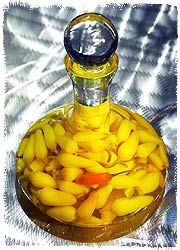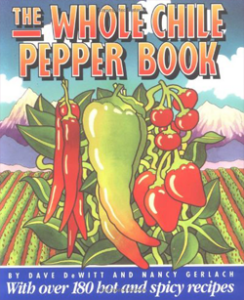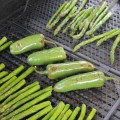Chiles lend themselves well to pickling or preserving in a brine or solution of vinegar and other seasonings. They can be pickled in jars by themselves or in combination with other vegetables. Colorful chiles make attractive pickles, so use Habaneros, red Serranos and Jalapenos, Chinese Multicolors, Yellow Wax Hots, and even fresh red Thai peppers.
Here are some pickling basics to follow no matter what recipes are used:
• Use only non-iodized salt and never use a salt substitute.
• Use a vinegar with an acetic acid content of 4 to 5 percent.
• Use distilled vinegar, not cider vinegar (which will discolor
the food).
• Do not boil the vinegar for a long period of time, as this
will reduce the acidity.

Photo by Jeff Gerlach
Blister and peel the chiles, remove the seeds, then wash and dry. Pack the pods loosely in sealing jars, leaving one inch head space. Add one quarter teaspoon salt per pint jar and then add boiling water, again leaving one inch head space. Tighten the lids on the jars and place them in the pressure canner. Process the pint jars for thirty-five minutes.
Here are some hints about pressure-canning: let the steam escape the full 10 minutes before closing the petcock; at the end of the processing, let the pressure fall to 0 — that takes about 20 to 25 minutes; and after opening the petcock, wait 5 minutes before opening the lid of the pressure-canner. As an additional safety precaution, always boil home-canned chile for 15 minutes before eating to prevent botulism poisoning. Stir it frequently.
The pressure-canning method may also be used with salsas or the careful cook can use the water-bath method. Remember that both the chiles and tomatoes are low-acid foods, so when using the water-bath method, the acid levels of the salsas must be increased by adding vinegar or lemon or lime juice to the recipes.

Editor’s Note: The great information above is an excerpt from The Whole Chile Pepper Book, which you can buy here.
Latest posts by Mark Masker (see all)
- 2024 Scovie Awards Call for Entries - 07/07/2023
- 2024 Scovie Awards Early Bird Special: 3 Days Left - 06/29/2023
- 2024 Scovie Awards Early Bird Deadline Looms - 06/25/2023








